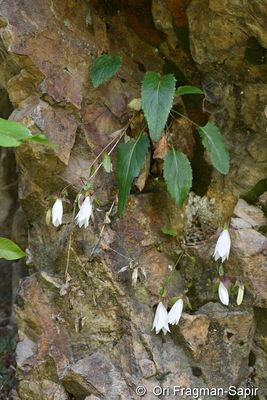-
General Description
-
The birch-leaved bellflower is a large-flowered species found in north-east Turkey.
The genus Campanula (the bellflowers), includes a wide variety of plants - many too large for a rock garden - as well as numerous smaller, more compact species. They are found across the Northern Hemisphere but their centre of distribution is in the Caucasus Mountains (the area between the Black Sea and the Caspian Sea, which forms the border between Europe and Asia).
Campanula betulifolia is a beautiful, large-flowered species. The second part of the scientific name, the specific epithet, 'betulifolia', refers to the leaves, that are similar in appearance to those of Betula (birches).
The German botanist, Karl Koch (1809-1879), described C. betulifolia in 1850. Koch had a broad range of interests, including zoology, geography, anthropology, history and archaeology, but his main interest was botany. From an early age he had dreamed of seeing the Caucasus and in 1836 he began the first of two expeditions to that region. It was possibly on his second expedition (1843-1844), along the Black Sea coast of Turkey, that he collected C. betulifolia.
-
Species Profile
-
Geography and distribution
Found in north-east Anatolia, in Turkey, in the provinces of Giresun, Trabzon, Rize, Artvin, Sivas, Gümüşane, Bayburt and Erzurum.
Description
Grows to around 10-25 cm tall. The leaves are ovate to broadly ovate (egg-shaped), with sharply dentate (toothed) margins.
The buds are pink, and produce white or, rarely, pale pink flowers. The flowers usually hang, and are campanulate (bell-shaped) and held in clusters on spreading, branched stems, in a corymb-like inflorescence (a flat-topped group of flowers where the branches of the flower stalk start from different points but reach the same level) beyond the tufts of leaves. The flowers are 3-4 cm long and have pointed corolla (petal) lobes that are around one fifth to one quarter of the length of the corolla.
Taxonomy
Jürgen Damboldt (German botanist 1937-1978) recognised six subgenera of Campanula in his account of the family Campanulaceae for the Flora of Turkey.
Campanula betulifolia was placed in the subgenus Campanula , section Symphyandriformis . In this section the anthers (male parts) in younger flowers are partly connate (fused) into a tube around the style (female parts). This characteristic places the species in this section very close to the genus Symphyandra , in which the anthers are connate into a tube, even in mature flowers.
Threats and conservation
Some hydroelectric dams are planned or already under construction on the Çoruh River in Turkey. The resulting artificial lakes will engulf some important habitats for Campanula betulifolia .
A conservation rating of 'Lower Risk - near threatened' has been suggested by Güner and Wilford in Curtis's Botanical Magazine , reflecting the uncertain nature of these threats.
Uses
Campanula betulifolia is cultivated as an ornamental.
Cultivation
Campanula betulifolia was probably introduced into cultivation early in the 20th century and in 1937 a pink-flowered form received an Award of Merit at the Chelsea Flower Show.
It is a hardy species that can be grown in the open, if planted in a crevice or in very free-draining soil. However, the delicate nature of the flower stems means that it will look best if protected in an alpine house or cold frame.
Although C. betulifolia can be kept for a number of years if fed regularly and given a large enough container, seed is best sown annually to provide a steady supply of young, vigorous plants. During the winter, most of the leaves die away and watering should be reduced. The following spring, new foliage appears and by early summer the plants will be in full flower.
This species at Kew
Campanula betulifolia can be seen in the Davies Alpine House and growing in the Rock Garden at Kew.
Pressed and dried specimens of Campanula betulifolia are held in Kew's Herbarium, where they are available to researchers, by appointment. The details, including images, of three of these can be seen online in the Herbarium Catalogue.
-
Distribution
-
Turkey
-
Ecology
-
Crevices in volcanic igneous and limestone cliffs, at 250-2,285 m.
-
Conservation
-
Preliminary assessment of Lower Risk - near threatened.
-
Hazards
-
None known.

%20(1)_fullsize.jpg)


